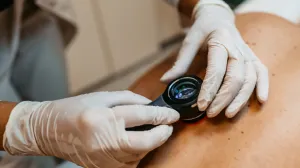
Eczema is a problem with the skin barrier, causing dry and itchy skin. While eczema often flares up in the fall or winter months, it can also worsen with heat and sweat. Airborne allergens such as pollen can contribute to eczema in the spring as well.
Preventing + treating eczema at home
“Eczema looks different at different stages, ages and skin types,” said Dr. Robinson. “It’s commonly described as ‘the itch that rashes.’”
The first step in treating eczema is preventing flare-ups by avoiding irritants and triggers. For some, this means avoiding dry air, while for others it involves steering clear of irritants like fragrance. Moisturizers that help restore the skin barrier provide essential protection.
Dr. Robinson recommends using a fragrance-free soap and bathing in lukewarm—not hot—water. To treat eczema at home, she suggests applying a liberal amount of a thick ointment, such as Aquaphor or petroleum jelly. The product should be thick enough that you scoop it from a tub rather than pump it from a bottle. The best time to apply the ointment is immediately after your child’s bath, to lock in as much moisture as possible.
Running a humidifier in your child’s room can also help by adding moisture to the air. However, it's very important to clean the humidifier and change the air filter regularly to prevent mold and bacteria buildup.
The first step to treating eczema is to prevent it from occurring in the first place by avoiding irritants and triggers. For some, this is avoiding dry air, while others need to avoid irritants such as fragrance. Moisturizers that help restore the skin barrier provide critical protection.
When to see a doctor
If using thick creams, avoiding fragrances, and running a humidifier don’t help relieve the symptoms of your child’s eczema, they may need to visit their pediatrician or a pediatric dermatologist. A prescription topical steroid or alternative cream may be needed. For some patients with moderate to severe eczema not responding to topical medications, an injectable medication can be considered.
We want to help treat your skin so you can keep playing and enjoy being a kid.
Dr. Sarah Robinson, pediatric dermatologist
Other common spring rashes
Eyelid dermatitis
One of the most common rashes we see during spring is a rash on the eyelids that is related to environmental allergens in the air, such as pollen. Eyelid rashes can also be caused by the transfer of allergens from fingers to the thin, sensitive skin of eyelids. To protect the eyelids, Dr. Robinson recommends applying a layer of ointment like petroleum jelly before going outdoors and then rinsing the face after coming inside. This can be followed by applying more moisturizer. Avoid the temptation to rub or scratch whenever possible. Instead, try applying a cool compress to help reduce any itch. Another trick is to store a tub of moisturizer in the fridge to use on itchy skin.
Lip licker’s rash
One form of this is a rash commonly known as lip licker’s rash. Exactly as it sounds, this rash is dry skin, sometimes with discoloration on and around the lips. The rash can appear red, darker in color or just dry depending on the person’s skin type and color.
The most important step to treating the rash is to avoid licking your lips, followed by applying cream or ointment frequently.
While you may think that applying lip balm and lip gloss will help this rash, it can actually do the opposite. These products contain several ingredients that could be irritating to your child’s skin. For example, some contain beeswax or fragrance. Certain foods, including citrus, can also be irritating. Stick to Aquaphor, petroleum jelly or try a diaper cream containing zinc oxide before bed.
Hand eczema
Hand eczema is more common during colder months when children are frequently washing their hands and experiencing shifts between wet and dry skin. Hand sanitizers and even homemade slime recipes can irritate the skin. To treat hand eczema, use a gentle soap and moisturize often. Dr. Robinson recommends applying a thick layer of moisturizer at night and having children wear white cotton gloves, if tolerated.
When playing with slime or other potentially drying substances, try wearing gloves or placing the slime in a plastic bag so kids can still enjoy it without direct contact.


